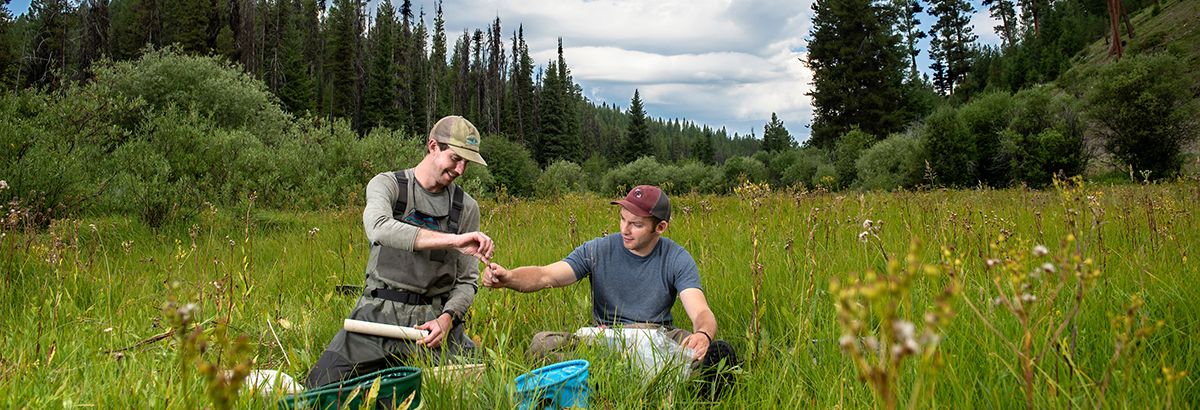Student Spotlight: Louise Johns
Louise Johns is a recent graduate of the Master’s program in Environmental Science and Natural Resource Journalism at the Ñý¼§Ö±²¥. Her Master’s project—Buffalo Renaissance: the Northern Plains Tribes’ Path to Self-Determination—specifically focuses on the Blackfoot Confederacy’s efforts to restore bison to their historical range in Montana and Alberta. Johns’ photo essay and written story will be published in Undark Magazine this fall. She will continue to follow Northern Plains bison restoration with support from a National Geographic Society grant.
STORY TRANSCRIPT
So, this quote that really resonates with me as to you know why I'm a photographer, is by Robert Adams. And it goes, "The job of the photographer, in my view is not to catalogue indisputable fact, but to try to be coherent about intuition and hope."
I’m Louise Johns and I’m a master’s student in journalism at the Ñý¼§Ö±²¥.
So, my dad is Chris Johns, and he worked for National Geographic as a photographer for about 40 years. The first time I like really connected with a camera was when I was about 10 years old. And my dad was working on a story, his last story for National Geographic as a photographer. And we were photographing wild horses in the Pryor Mountains. It was just my dad, me and his assistant, Bobby Model. And we were camping in the Pryors for about a week. And one day we were out in this field, and the horses were like, way off in the distance. And my dad had set up his camera on a tripod for me to just kind of like click away and, and I wasn't that, I wasn't that interested in cameras. But I went over and I was sort of like checking it out. Mostly because I was bored and looking, looking through the lens. And meanwhile, my dad and Bobby are back at their truck kind of doing their own thing. And the horses slowly started coming up to me and, and like sort of checking me out and I was just super still and quiet with the camera. And I remember, I remember looking through the camera and shooting pictures of the horses and how, what a beautiful kind of expression that was to be able to see through the lens of a camera, these, these animals and then what I could do with that after. I didn't really think about that moment, again until much later when I decided to study journalism. When I actually moved out west from Virginia and came to this program as an undergrad. And I said, you know, I think I'll try a photojournalism class.
I'd gone to visit a school with my mom, and I was driving back home from that visit with her. And I was like, “Gosh, I just, I don't want to go to any of these schools that I've, I've looked at so far.” Most of them were on the east coast. And my mom said, “Well, can you describe the kind of place you think you belong?” And, and I said, “Well, I think I want to be in a in a mountain town and I want to be you know, I want to be somewhere where there's mountains and an outdoor lifestyle and wild places.” And, and she said, “Well, that sounds like the Ñý¼§Ö±²¥.” I came to visit and just like fell, fell in love with the school and, and the place.
My master's project is about bison restoration. And specifically, the native tribes restoring bison. The Plains Indians tribes, all lived off of bison for thousands of years prior to European settlement. With the near extinction of the bison in the late 1800s. Native people also, you know, really suffered from, from the loss of bison from a sustenance point from a cultural point and from a ceremonial point. And so, my project is exploring what this meaning is and sort of where they are in trying to bring bison back and how, you know, federal Indian policy has played into where they are now and where they're going in the future.
I hope it will reveal how much we don't know and don't understand about Native American life and what's important to people now, what was important in the past and what's important for their future. The development of this country has been in large part at the expense of the indigenous people. And so, I think, illuminating and trying to, to help communicate, that they, this is such a different way of seeing the world, the way of, a way of looking at landscape. I hope it helps people think about the impact and the influence that, that modern mainstream society has had on indigenous people.
I feel like a really big part of how I work too is, is actually going and experiencing what the people that I'm trying to tell the story about are experiencing. And so that's really getting to know your subject. And that you can't really know something until you've gotten a taste of it as, and experienced it as on a human to human level, not just as a sort of, I'm just an observer and I'm, I'm taking your pictures. It's more of like really integrating yourself into the lives of those people or that place.
